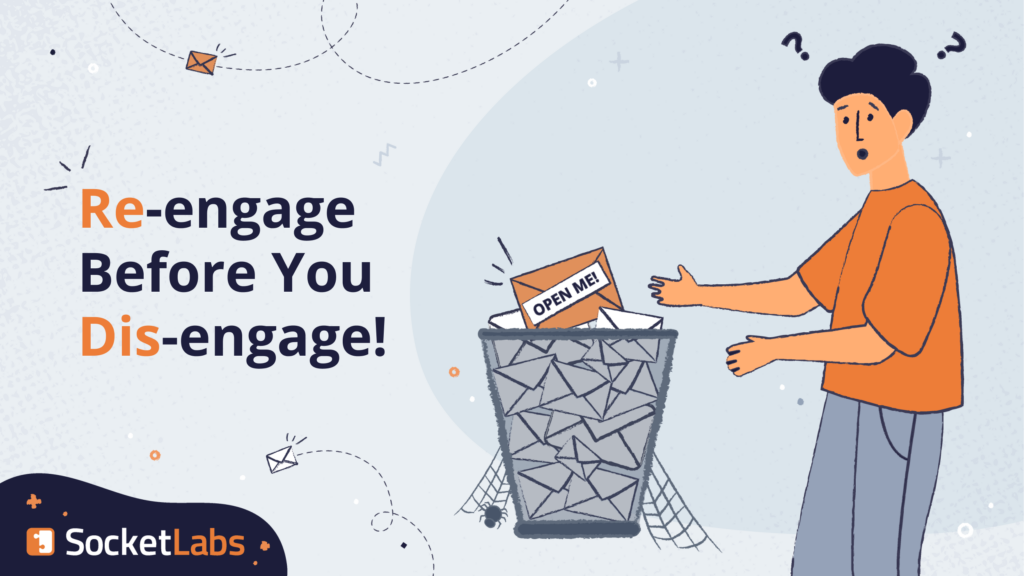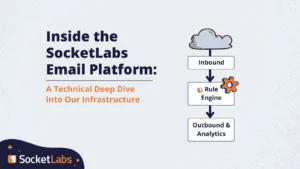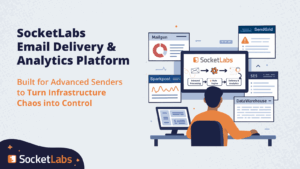
Just a couple weeks ago we published a blog about a somewhat depressing topic: sunsetting or deleting addresses from your list due to inactivity. Now, we know no one wants to make a list smaller, so to help you avoid needing to make major cuts, we’re back to talk about re-engagement!
We’ll explore what re-engagement means and why you should do it frequently so you can reserve sunsetting as your last resort. Plus, we’ll share some advice and strategies for you to try out. Here we go!
What is a Re-engagement Strategy?
A re-engagement strategy is a dedicated attempt to get a recipient to interact with your mail after a period of inactivity. We explained what criteria you might use in our sunsetting blog, so head over there for a more in-depth explanation.
Remember, this is not just any ol’ email distribution. This is a highly curated list of individuals who meet your criteria of “unengaged,” and the messaging should be clear in its attempt to get people to open or click your emails again. These should be notably different than the kind of content you are typically sending.
The lists you use for your re-engagement efforts should be much smaller in size, because after all, not everyone joined your list at the same time. They didn’t stop engaging on the same day, either.
The addresses you plan to re-engage should be similar in attributes, like “three months with no opens,” and should not resemble a “blast” at all. These are supplements to your typical email operations, so keeping the volume down will help protect your deliverability as well. Remember, mailbox providers don’t like sudden spikes in volume from the same sender, so be strategic.
Why Try to Re-engage?
Valid email addresses aren’t easy to get, especially if you’re doing it the right way and not purchasing lists or emailing people without consent. All (real) addresses are valuable, so when you know you have a potential or past customer, you want to retain them. Plus, there are myriad reasons someone could become unengaged over time, so to not explore what could have happened or what could be changed is a sure way to not improve in the future.
Email Drives Consumer Decision-making
According to Hubspot in 2023, 59% of people say marketing email influences their purchasing decisions, so your email has a good chance of making a direct impact on your business’s bottom line. Keeping as many addresses engaged as possible is a major factor in influencing customers to purchase, so before you give up on someone, be sure you’ve tried everything you can to re-pique their interest.
That said, give them plenty of time to engage with you before you consider your re-engagement campaign a lost cause. Consistently getting your mail in their inbox may be helping with brand awareness at the very least, because even if they aren’t engaging, your consistent presence could keep you top-of-mind when they suddenly have a need for your product.
Your Findings Can Inform Your Overall Strategy
You can learn a lot from re-engagement campaigns, too! Depending on what kinds of tests you do, how people react to your experiments can give you good insights into what tactics to keep and which to abandon.
Is a certain kind of offer more enticing, more reliably? Could you be segmenting your lists more strategically to create better recipient experiences? Are these folks engaging with our brand via other channels? Learn from what they like over there, or perhaps market to them on those channels and let ‘em go from your email list. Just a thought.
You can also make discoveries unrelated to your email strategy when you get very intentional about segmentation and testing. For example, when doing a small-batch re-engagement campaign, you could discover these addresses aren’t engaging because you’re struggling to get your mail delivered to their inboxes.
At the end of the day, any effort to retain a valid address should at least be explored because you never know what might change someone’s mind.
Re-engagement Strategies to Consider
As with basically everything in email, there is no one-size-fits-all, so you’ll need to find the perfect mix for you. You can either do a full-fledged campaign or you can do one-off actions to try to get people interacting with your mail again.
Here are some ideas to get you started on building your plan.
Direct Re-engagement Email
Your biggest question will be whether you want to make it clear to your recipients you are trying to get them to re-engage. Do you want them to know the goal is re-engagement?
If so, you can send one or two emails with a clear call to action using a message like, “We haven’t seen much interest from you lately. Are you still interested in receiving our mail?” You could do this in the subject line itself, even, to see if that entices an open.
Then, the call to action could be to either reconfirm their interest with a button click or affirm your suspicion they’re not interested anymore by unsubscribing. Make it really easy to unsubscribe, too. This isn’t the moment to have them looking the email up and down to find out how to opt out if it’s super easy to opt back in.
Pros of this Approach
By being direct, you’ll get an answer pretty quickly! Let’s say you used the subject line example: “Is this goodbye?” Anyone who didn’t click on the button to re-confirm their interest can be unsubscribed from your lists. Those who did what you asked will live [on your lists] to see another email.
There’s very little room for misinterpretation when you’re upfront about your intent to re-engage. You are asking a clear question with a clear CTA, so you can be sure they understand what they’re being asked to do.
Cons of this Approach
Inboxes are crowded and people probably won’t open (or even see!) every single email they’re sent. If you only try to re-engage once, you might miss out on would-be re-engaged subscribers.
Similarly, even if you send a couple tries, this way of re-engagement might be too quickly resolved for your business. Some orgs might want more than only one or two data points before making a decision like removing an address from a contact list.
The direct ask could be out of character for your brand as well. If you’re not comfortable with telling people to confirm their interest or hit the road, that’s ok! This just might not be the way for you. And, unless you’re providing some kind of value in this email, like discounts or special access to a cool new thing, it’s pretty self-centered, which…might not be the best way to get unengaged recipients to act.
Indirect Re-engagement Email Series
OK, so maybe being direct in your re-engagement isn’t really your bag. Try enticing people to re-engage using a series of email with different tactics to see if you can find new ways to segment existing contacts into lists with a more engaging approach to them.
For instance, segment your unengaged audience out and offer them a more significant discount or other kind of offer. You could also try radically different subject lines or sender friendly From than before.
Then, for anyone who doesn’t engage with that first email, try offering something different. Maybe personalize the subject line and reference a past purchase, or offer a valuable resource, like a guide, instead of an incentive to purchase. If you normally send robust content they might find overwhelming, this is a good time to keep it short and sweet.
Depending on how many chances you want to give your unengaged folks, you ultimately can wrap up with a final email where inactivity will mark them for deletion. This could be direct, like an email we described earlier, or it could simply be the decision to remove anyone who doesn’t click on any of the re-engagement emails in your series.
Pros of this Approach
You can learn a lot about the people on this list. Do 25% of them respond well to personalization? Did 10% redeem the discount?
With this info, you can better segment them to lists where the regular emails will be more interesting to them, or you can test that tactic out with a larger population of recipients to see if it has similarly positive results
You aren’t quickly deleting people based on their mood in one moment, either. Maybe the first email in your re-engagement series didn’t float their boat but the second email did. Without a series, their mood (or how busy they are, or how active they are with their inbox) on the day of the ONE email determines their total fate.
Cons of this Approach
Unfortunately, a creative series with lots of variables and nuance isn’t a fast fix. It could take a lot of work to test bunches of different subject lines, segments, approaches, messages, workflows, etc. Depending on your company, you might have to weigh the value of your investment against the value of the addresses you’re trying to re-engage.
For some, a big undertaking like this is only reasonable if certain conditions are met: This batch of unengaged addresses previously purchased $1 million in goods and losing them is very dangerous.
For others, all addresses are considered potential goldmines and any level of work to keep them is justifiable. Only you will know!
Another complicating factor is how difficult it can be to monitor engagement on emails with so many variables. Without a good way of looking at your first-party data, especially at a recipient-level, it can be challenging to find insights. Typical email service providers (ESPs) give pretty surface-level stats and extra deliverability tools usually rely on third-party guesstimates, so puzzling together exactly what to do with your findings at the recipient level can be a real struggle.
SocketLabs Spotlight users have the benefit of using tags, metadata, and SuperTags, plus their own first-party data, to help them organize and analyze their re-engagement campaigns.
How to Make it Work for You
There are a few important housekeeping-style things you should make sure you do, regardless of how you approach your re-engagement strategy.
Ensure your lead magnets and signup forms align with your product offering and the emails you’ll send, making it less likely people will end up disengaging in the first place – no need for a re-engagement activity for them at all.
Use automation! Create a sunset policy and then set up automated triggers to move someone over into the re-engagement groups on a set schedule so you don’t have to do it manually each time. This makes re-engagement always on, less time-consuming and stressful, more accurate and consistent based on data, and, as always, less error-prone due to less manual work.
Finally…Don’t just pour re-engagers back into the same old list and content they snoozed on in the first place. Consider how you can use what you’ve learned about their interests and behaviors during your testing and re-engagement efforts to tailor an email strategy suiting the needs of similar-minded recipients.
In fact, you should use all the insights you learned to create a more engaging experience for all your recipients. Try emulating your most successful subject lines or using more of the most engaging offers or experiences you provided in your content.
When All Else Fails…
Try as much as you can to put those learnings into action. But at the end of the day, it’ll be necessary to make some tough decisions.
Cut your losses and remove the dead weight from your lists to improve your deliverability, and do that regularly as well.
If you aren’t sure exactly how your engagement is right now, or you’re only looking at third-party information to make guesses at what’s working, consider SocketLabs Spotlight analytics, which takes the first-party information you need to do a re-engagement campaign into account as well. It’s free for 90 days, and whether you send email from us or not, you’ll get to see a whole new world of data. Why not give it a shot?







